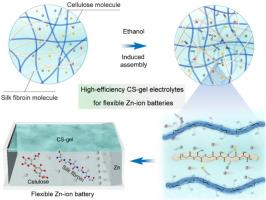Bio-based supramolecular dual-network gel electrolytes with synergistic mechanical robustness and ionic conductivity for high-performance flexible Zn-ion batteries
IF 20.2
1区 材料科学
Q1 CHEMISTRY, PHYSICAL
引用次数: 0
Abstract
Gel electrolytes offer attractive potential for flexible Zn-ion batteries due to their safety, structural flexibility, and ionic conductivity. However, challenges persist in achieving sufficient mechanical strength to prevent dendrite growth, ensuring efficient ion transport, and mitigating side reactions between electrodes and sustainable gel electrolytes. We present a supramolecular gel electrolyte (CS-gel) developed through ethanol-induced molecular assembly of cellulose and silk fibroin. The CS-gel features interwoven hydrogen-bond (H-bond) networks and β-sheet domains, achieving an ionic conductivity of 14.39 mS cm⁻¹ and a tensile strength of 1.14 MPa. The polar groups (-OH, -NH2, -COOH) within the gel interact dynamically with Zn2+ ions, reorganizing solvation structures to inhibit dendrite formation and reduce parasitic reactions. In a flexible Zn//MnO₂ battery, the CS-gel retains 97.67 % capacity after 1500 cycles at a discharge rate of 0.5 A g⁻¹, demonstrating stable long-term cycling performance under bending and at temperatures as low as -20 °C. This supramolecular design, integrating natural biopolymers, presents an effective and sustainable approach to high-performance flexible energy storage devices.


高性能柔性锌离子电池用具有协同机械稳健性和离子电导率的生物基超分子双网络凝胶电解质
凝胶电解质由于其安全性、结构灵活性和离子导电性,为柔性锌离子电池提供了诱人的潜力。然而,在获得足够的机械强度以防止枝晶生长、确保有效的离子传输以及减轻电极和可持续凝胶电解质之间的副反应方面,挑战仍然存在。本文介绍了一种通过乙醇诱导的纤维素和丝素蛋白分子组装制备的超分子凝胶电解质(CS-gel)。cs -凝胶具有相互交织的氢键(h -键)网络和β-片结构域,离子电导率为14.39 mS cm⁻¹,抗拉强度为1.14 MPa。凝胶中的极性基团(-OH, -NH2, -COOH)与Zn 2 +离子动态相互作用,重组溶剂化结构,抑制枝晶形成,减少寄生反应。在柔性Zn/ mno2电池中,CS-gel在0.5 a g⁻¹的放电速率下,在1500次循环后仍保持97.67%的容量,在弯曲和低至-20°C的温度下表现出稳定的长期循环性能。这种整合天然生物聚合物的超分子设计为高性能柔性储能装置提供了一种有效和可持续的方法。
本文章由计算机程序翻译,如有差异,请以英文原文为准。
求助全文
约1分钟内获得全文
求助全文
来源期刊

Energy Storage Materials
Materials Science-General Materials Science
CiteScore
33.00
自引率
5.90%
发文量
652
审稿时长
27 days
期刊介绍:
Energy Storage Materials is a global interdisciplinary journal dedicated to sharing scientific and technological advancements in materials and devices for advanced energy storage and related energy conversion, such as in metal-O2 batteries. The journal features comprehensive research articles, including full papers and short communications, as well as authoritative feature articles and reviews by leading experts in the field.
Energy Storage Materials covers a wide range of topics, including the synthesis, fabrication, structure, properties, performance, and technological applications of energy storage materials. Additionally, the journal explores strategies, policies, and developments in the field of energy storage materials and devices for sustainable energy.
Published papers are selected based on their scientific and technological significance, their ability to provide valuable new knowledge, and their relevance to the international research community.
 求助内容:
求助内容: 应助结果提醒方式:
应助结果提醒方式:


